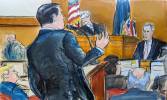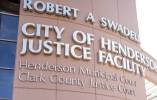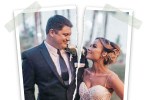Inquest closed to the public — again
Clark County's coroner's inquest process is highly controversial because it almost always results in police officers being found blameless in the shooting deaths of local citizens -- a result, primarily, of prescribed jury instructions that require such a finding unless the jury believes police officers acted "with criminal intent."
But, while plenty of the police conduct examined in past inquests has been alarming -- look up the deaths of Henry Rowe, John Perrin and Orlando Barlow, for starters -- last week's inquest into this summer's shooting death of West Point graduate Erik Scott by three Las Vegas police officers in broad daylight outside the Summerlin Costco store, where he had been shopping, may be the highest-profile proceeding of its kind in the valley's history.
You'd think those in charge of the inquest process, therefore, would have wanted to be on their best behavior in setting this one up. Many expected the inquest to be a sham, of course, "clearing" the officers as a preliminary to the Scott family filing a civil lawsuit -- the usual outcome.
And yet, they did it again.
The Erik Scott coroner's inquest was not open to the public.
Sheriff Doug Gillespie visited us here at the Review-Journal offices on Aug. 3. He acknowledged the importance of an open-to-the-public inquest process to maintain public confidence in that process, and in his department. "I'm not lookin' at hidin' anything, nor is my organization," the sheriff said. That's why they were going to hold the Erik Scott inquest in the largest available courtroom, so all who wanted to attend could do so, the sheriff vowed.
But that turned out to be the usual pile of crap.
The coroner's inquest got under way at 10:50 a.m. Wednesday, the first day of autumn, at the downtown Regional Justice Center. I was there.
Once I was through the metal detector and all the "wanding" rigmarole, I tried to find the Scott inquest on the big docket board, knowing it ought to be listed in courtroom 16.
I finally gave up and asked at the information desk. They told me it was in ground-floor courtroom 1-B, a courtroom big enough to hold 75 to 80 people.
I entered courtroom 1-B, where about 15 people were watching the proceedings, which were just getting under way, on a closed-circuit video screen. I trooped back to the information desk.
"They're just watching the proceedings on TV in there," I said. "I want to attend the actual inquest. Is that in courtroom 16?"
"Only invited people can get in there, it's not open to the public," said the older guy in the red-checked shirt.
"Are you kidding me?" I asked, taking out a pen and writing down his precise words. "What's your name?"
The man at the information desk refused to give his name. I asked him to call the head of security for the building. He phoned someone named George, who never showed up, although I stood there tapping my foot for more than 12 minutes by the clock.
I finally took the elevator up to courtroom 16-D. I made it through the first set of doors but was then told to leave by a cadre of four armed marshalls, before I got through the second set of doors. The one whose nameplate said "Lemke" told me all the seats were full. I said, "No problem, I'll wait till someone leaves, and then take that seat."
Marshall Lemke replied: "There might be some seats open after the voir dire, but the coroner will decide who gets them. They may not be first-come, first-served, open to the public."
"OK, let me talk to the coroner," I said.
He wouldn't let me talk to the coroner.
Courtroom 16-D, from the brief look I got at it, would appear to be a normal-sized "upstairs" courtroom at the Justice Center, which means it could hold about 32 people, not including the judge, jury and active attorneys. There were perhaps eight people hanging around in the hallway outside. Add the 15 folks watching on TV downstairs and you get 55 people who were interested in attending the proceedings on Wednesday morning.
In other words, courtroom 1-B, which was open and available, could easily have held everyone who wanted to attend this so-called "public" inquest, with at least 20 seats to spare.
So why wasn't the inquest opened up to the public, by holding it in the largest available courtroom, as Sheriff Gillespie promised?
Sure enough, those of us who ended up watching part of the proceedings downstairs on TV (we couldn't see the jury, or much of anything else other than the judge and one witness at a time) saw Justice of the Peace Tony Abbatangelo, the convicted wife-beater who was running the inquest, look into the camera and announce -- just as I knew he would -- that if any member of the public had any "personal and direct" information and wanted to come forward and testify, they should approach his marshalls with that information, blah, blah, blah.
Anyone at home watching on the county's TV channel could have gotten the impression Abbatangelo was addressing a huge courtroom full of members of "the public." But he wasn't, of course. Once again, as always, the proceedings weren't open to the public.
Wednesday's proceedings dealt primarily with the deceased Erik Scott's use of prescription pain killers, with prosecutors cross-examining his doctors as though they were there to prosecute the deceased, rather than examine the conduct of his killers. Medical Examiner Alane Olson did note, however, that the deceased was shot seven times, five times in the back, with one bullet entering "the underside of the buttocks" and penetrating up through his bowels and bladder.
That is to say, one of our proud boys in beige shot Erik Scott from behind, in the butt, after he was face-down on the ground, already dying with at least two rounds of .40-caliber through his heart.
But it's OK; they'll all be cleared of any wrongdoing, in that secret little courtroom to which members of the public aren't admitted, because Sheriff Doug Gillespie isn't "lookin' at hidin' anything, nor is my organization."
Vin Suprynowicz is assistant editorial page editor of the daily Las Vegas Review-Journal, and author of "Send in the Waco Killers" and the novel "The Black Arrow." See www.vinsuprynowicz.com/.























